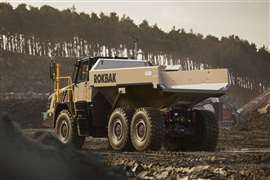Read this article in Français Deutsch Italiano Português Español
Interview: Optimizing electric fleet management
02 April 2024
 Photo: scharfsinn86 via Adobe Stock
Photo: scharfsinn86 via Adobe Stock
Founded early last year by CEO Anant Kapoor and CTO Eric Daoud, Guided Energy aims to help fleet owners better manage their fleet of electric vehicles (EV).
The company provides software that enables owners to automate EV fleet operations from charge management and dispatch through to reporting and expense management.
Despite still being in its infancy, the company has garnered significant attention and support, and recently closed a US$5.2m seed round with Sequoia and Dynamo.
It also counts former Formula One driver Nico Rosberg as one of its angel investors.
IRN recently caught up with Kapoor, a Cambridge & MIT engineer, to discuss how the software is helping to maximize fleet efficiency, how it could transfer over to the equipment rental industry and why he is predicting fast growth for the company.
IRN: Tell us about the solutions offered by Guided Energy
AK: We’re making it easier, cheaper and more profitable for commercial fleets to charge, dispatch and operate the fleet of commercial electric vehicles. Today we have over 1000 electric vehicles already connected onto our platform and that’s growing fast.
We’ve been helping fleets of all shapes and sizes, mostly in car rental, small delivery and transportation to improve and get the most out of their electric vehicles.
IRN: Having launched early last year, what have been some of the key milestones and developments?
AK: We’ve released our first product, which has connected over 1,000 vehicles to date. Some of the big milestones include our published customer Sixt, the car rental company, and Addison Lee in the UK who are both now on-boarded onto the platform.
Really what our product does is help across three main areas. The first is dispatch, where we help allocate vehicles based on charge and the job requirements to the right job.
 Kapoor (left) and CTO Eric Daoud (right). Photo: Guided Energy
Kapoor (left) and CTO Eric Daoud (right). Photo: Guided Energy
The second is monitoring those vehicles and showing that they’re hitting and managing the promised supply, and the third is turning around those vehicles and prioritizing power into the right vehicle so that the operating cost is as low as possible.
On top of that, we’ve been collecting a lot of vehicle data and that’s been helping us do all sorts of advanced range analytics so that on a given day, depending on the weather, we know exactly what the likelihood range for a vehicle would be.
We can even get that to a specific vehicle level so we can understand it’s battery health, but also how well the driver is driving it.
We’ve been building a lot of intelligence around the data we’re collecting, not only from the vehicles, but also from the charging ecosystem, whether it’s in their depot, on the road or at employees homes.
IRN: Who are some of those companies that you’re working with on that?
AK: We haven’t published any partnerships today, but it includes the majority of the OEMs that we have compatibility with.
I would say any of the top five telematics companies are ones that we can already integrate on to our platform.
IRN: Are other companies doing anything similar in this space?
AK: Most of our customers we’ve helped, we haven’t seen them using or even sourcing any other tool that’s helping them streamline their EV operations in the way that we can.
The closest that we have seen is in some cases they’ve been trying to capture some of this data themselves and build their own internal tooling, but usually where that tends to fail is these problems are extremely dynamic and in the diesel world we didn’t need to solve for some of these dynamic variables.
When it comes to electric, you’re range should change in real time. The power you can draw, the price of the grid could change in real time and that’s where it looks very different and its quite hard to build in-house.
IRN: How do you actually connect to the vehicles?
AK: We connect in one of two ways, either via APIs to their telematics provider if they already have installed telematics, and for certain OEM’s through the OEM cloud account we can pull the battery data again via API directly. In many cases, no hardware is required.
One of the beauties of the ecosystem is that you can control these chargers and control the flow of electrons out of them all via APIs and software services. It’s the same with the vehicles that there’s this huge amount of real time data that you can access.
What’s been really hard for fleets is that all of these data points sit on very distinct systems and what we’ve done is built out the integrations to bring that patch work together to help fleets access and make use of all of this data and the ecosystem.
IRN: How are the findings relayed to the customer?
AK: We connect to their vehicles, they’re charging ecosystem and their legacy job management or route management system depending on what they have. They have two teams normally using our product.
The dispatch team that use it for allocating that vehicle to upcoming routes and then based on that they then monitor those vehicles on the road to track progress against those routes and identify where charging may be needed.
The second is the fleet team who are usually looking at what the dispatch requirements are and ensuring that the right vehicles have the right amount of power to go out and be turned around for dispatch.
We help them increase the uptime of their vehicles, make sure that they’re maximizing the utilization of them and have them on the road for long enough. We can also help them with some of the analytics around what’s the cost, what’s your CO2 footprint so that they can just do this and that kind of monthly reporting.
On top of that, in line with this fundraising round, we are starting to invest in integrations with those charges so we can prioritize power where they might have microgrids, we can bring down the cost of energy by prioritizing things like solar and storage effectively same with their external charging.
We can help them tap into the best networks and again really maximize your uptime and lower their operating costs.
How easily could this transfer from commercial vehicles to equipment rental?
AK: We have been exploring it, especially as we’ve seen electrification pick up in these sectors. We’ve seen that many of the core EV operational challenges are quite similar from one segment to another.
It’s around the day to day EV operational tasks of how do I allocate my vehicles to the right jobs? How do I maximize the productivity of my fleet? Productivity is a hot topic, whether you’re a car rental fleet or a delivery fleet.
Our core product is really helping fleets maximize productivity and lower operating cost regardless of which industry.
What savings and productivity statistics have you noted?
AK: What we’ve seen is that we can help save customers up to $10,000 per year per electric vehicle split across the by increasing the vehicle productivity and reducing operating cost and it would definitely be skewed towards productivity.
IRN: You recently closed a funding round of $5.2 million. How will these funds be used?
AK: We’re using the response to fuel our growth, invest in R&D and on-board our massive pipeline of other customers in delivery, transportation and car rental. That is our focus going forward, to enable fleets of all shapes and sizes to receive the gains and maximize the profitability of their electric vehicles.
|
STAY CONNECTED


Receive the information you need when you need it through our world-leading magazines, newsletters and daily briefings.
CONNECT WITH THE TEAM











